Do you want to know how the new Oxygen Builder trades blows with the famous Elementor website builder?
Honestly, there has been lots of noise about these page builders. And so, we got influenced to talk about this topic.
For this sake, we have gone through both Elementor and Oxygen builders, to find everything in favor or at odds with them.
After combining our experiences with info from some of the famous SaaS reviewers on YouTube.
We have found several interesting facts about Oxygen vs Elementor that we would like to share.
Elementor vs Oxygen Builder - what we generally know
By definitions and functions, both Elementor and Oxygen Builder are WordPress page builder plugins.
You can use page builders to create your landing page, homepage, and all parts of a typical WordPress website.
In a word, they can be considered a site builder or website builder plugin due to how they allow you to build the whole WordPress site.
Let’s take a deeper look at each of them.
Elementor Page builder plugin for WordPress

A visual website builder, Elementor Pro, allows you to design and build a website from scratch.
Create hero pages, headers, or footers by simply dragging and dropping widgets inside the page and the process is insanely fast and simple.
Elementor actually makes it possible for any non-tech guy to be able to create stunning websites without touching any codes.
Offering better flexibility, the page builder has widgets for implementing specific interface designs.
You could have it all with Elementor Pro. Build pretty much anything you wanted with this WordPress plugin since it’s simple yet feature-rich.
For the icing on the cake, more than 7080 5-star Elementor reviews are baking this epic piece of tech.
Last but not least, Elementor page builder provides ready templates so the time to design a webpage gets reduced from days to hours.
Oxygen Page Builder plugin for WordPress
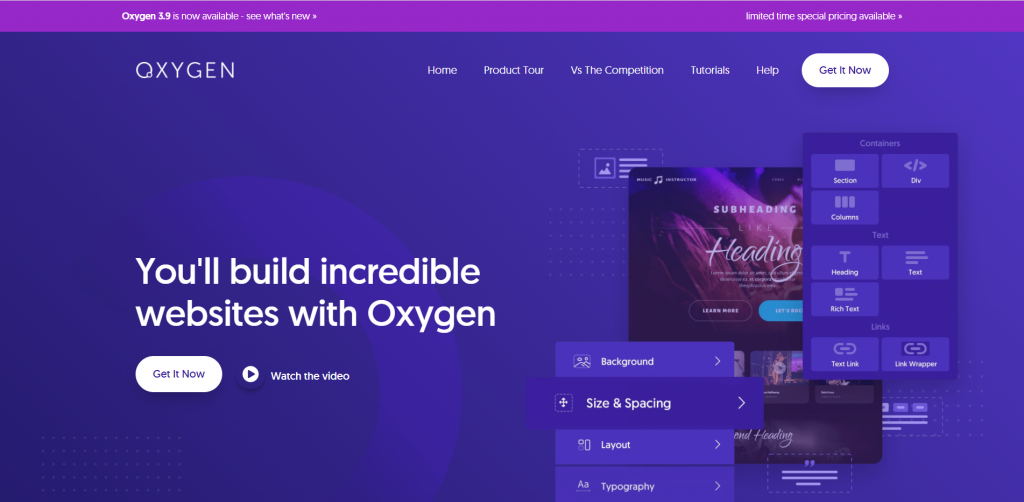
What is oxygen builder? A very hyped question.
Oxygen Builder is a relatively new page builder plugin for WordPress with competitive features like Elementor.
The core advantage of this page builder is that you no longer need any theme to build your website. The page builder itself acts as a theme.
This is not your average page builder; it’s a visual design tool that redefines how you create and manage your WordPress websites.
After all, you will find a decent amount of positive Oxygen builder reviews online. Proves how valuable this builder is.
Not just fast, Oxygen Builder is way faster than other builder plugins.
It trades blows directly with top page builders and that’s why you will find more Oxygen vs Divi or Oxygen vs Bricks articles everywhere.
But it has a drawback. A complicated dashboard & feature management system make this builder suitable for veteran developers only.
Not very beginner-friendly actually.
Of course, you can design flexible web pages, templates, headers, footers, hero pages, and more with this page builder plugin.
Also, We tried to find the meaning behind their logo
What we came across with the Oxygen Builder logo is fascinating.
According to our design experts, the logo has a profound meaning.
Basically, the Oxygen Builder logo symbolizes the earth and oxygen, a long-term sustainable relationship.
This meaning also reflects in the Oxygen builder pricing. They only offer lifetime packages at very cost-friendly price points.
Our experience with Oxygen Vs Elementor page builder
You may not know but we are at BdThemes, and we have been with Elementor Pro for more than 5 years now.
Why Elementor Pro? Even after trying several other page builders like Beaver Builder, Visual Composer, Divi Builder, WPBakery Page Builder, etc.
Surprisingly, we found Elementor Pro to meet our requirements the most.
Why I love Elementor? Well that’s a long story (coming up ahead in the features part).
But right after Oxygen Builder came on the market, we got our hands on it in the beta phase. Honestly, we liked how the page builder uses a lighter framework than Elementor Pro and has more speed in loading time.
But found a lack in performance and features for beginners to mid-level web designers.
Of course, not even Elementor is perfect. Both have their unique advantages and disadvantages.
Now, let’s stop the introductory and dive into the features comparison.
Let's compare both website builder plugins side by side
1. Elementor vs Oxygen Builder - feature comparison
As we are talking about Elementor vs Oxygen Builder here, we are bound to see a number of similarities and differences between their features.
Let’s see how much the features differ between these visual site builder plugins.
1a. UI Configuration
We always expect the page builder to provide the simplest user interface, so anyone can use it without a hitch.
That’s why they are developed in the first place, aren’t they?
So, comparing the UI of Elementor vs. Oxygen Builder leads us to a few discoveries.
Elementor Pro has the most user-friendly UI that contains a left-hand toolbar with everything you need.
You can pick any element or widget, change page settings, or customize each widget from the sidebar. Also comes with a Navigator system that lists all current elements inside the page (including sections & columns).
Plus, Elementor allows you to hide the menu sidebar anytime.
On the other hand, the Oxygen UI has a refreshed interface layout that tastes like a whole new experience.
But compared to Elementor, the Oxygen Builder UI is a bit complicated due to the cluttered menu bars and options all over the page.
In fact, Oxygen Editor has a complex structure that leaves beginners in a tough position.
Although the inline editing feature adds more to the web-building process, but it still does not simplify the whole thing for general users.
Experts will have a swift go at this though.
1b. Ready Templates
Templates are the best way to speed up your web design projects. The more variations you can get, the more diversified your designs will become.
One of the best things about Elementor is that you will get tons of templates with it that are ready to serve right now.
The page builder alone has more than 300 templates. With additional 3rd-party addons like Element Pack Pro, you can add 2600+ more templates to your inventory.
On the other hand, Oxygen builder does not have lots of templates. They have around 17 template kits available to try out.
So, you have to lean on your creativity more to get the designs done.
1c. Template Library Functions
Oxygen Builder certainly has the upper hand here because Oxygen’s Template Library functions are faster and easier than Elementor.
Because the library is integrated within the editor panel and takes a very short time to load and insert, you will love to use it more frequently.
Although Elementor offers a well-organized template library, they load slower and even slower when trying to insert into the page.
This is a point of improvement for Team Elementor to boost its advantages.
1d. Widgets and Modules
Oxygen Builder does not offer a great number of modules, but the available ones make great web designs.
Apart from link wrapper and shortcode wrapper, you can expect modules for posts, WooCommerce, pricing, Maps, etc.
But, Oxygen Builder made the most useful Oxygen editor modules available in a separate addon named Composite Elements. That puts most of the functions outside of the core builder.
Unlike Oxygen page builder, Elementor Pro offers plenty of widgets and modules you can use to design your websites.
You will get over 90 elements right from the start including both free and premium widgets.
All available modules come with the full set of customization controls, so you can easily change their appearances into your desired form.
Plus, just adding one 3rd-party addon, like Element Pack, can boost the number of widgets up to 300 in one shot.
In the battle between Oxygen vs Elementor page builder, Elementor stays ahead for its features.
1e. Customization Panel AKA Menu
As page builders can help you customize all pages inside your website, the sheer number of options is no joke.
The last thing you need is a confusing menu panel.
Elementor actually saves the day by offering a very straightforward menu system that even beginners find easy to adapt to.
Unfortunately, Oxygen Builder has a complicated menu panel.
Instead of sorting the options like Elementor, the latter combines options within options, making a weird turn in events on the menu panel.
The options are stacked and hidden deep inside the parent option.
And that’s why many people hated Oxygen UI after its launch.
Note:- Inside editor, Elementor lets you hide elements without deleting it. Oxygen however does not allow.
1f. Color Options
But Oxygen Builder has a unique charm to its element color controls.
That is, each color gets a name based on the color group and that’s pretty handy.
Also, unlike Elementor, Oxygen lets you stack unlimited colors to create gradient patterns.
I mean, WOW! This is a great option because it directly helps designers make creative changes to their designs.
On the other hand, Elementor only lets you stack two colors for gradient, much like what other page builders are going with.
So, take note of the color options.
1g. Global Color Options
But the global color options are a bit messed up in Oxygen builder compared to Elementor.
Yes, the colors got their own names so you can find them easily. But the labels don’t say where the color is applied to.
You will find all the global colors inside a list and now you need to figure out which one is in the header or body.
This problem is not present in Elementor though.
1h. Gutenberg Compatibility
Did you know you can save any template in Oxygen Builder and use it as it is in Gutenberg Builder?
Amazingly, Oxygen Builder is so compatible with Gutenberg that the saved designs or templates can be used inside Gutenberg flawlessly.
Also, the templates can be made into custom blocks for easy recognition.
This is where Elementor fails to impress WP users because the layout will almost break when converting from Elementor to Gutenberg.
1i. Theme Builder
Surprisingly, both page builders have Theme Builder features with intensive template builder functions.
IF you are a regular user of Elementor or Oxygen builder, you should be familiar with theme builder.
The feature opens the path to create and manage templates that directly affects the theme, modify the theme layout, and can be maintained globally or for specific pages.
Elementor has promised a well-arranged theme builder feature and they did it. It has header-footer, single post, single page, archive, search results, loop item, and error 404 page builders. We love it too.
Additionally, the integrated Oxygen Theme Builder works quite swiftly and lets you customize theme elements without a hassle.
So, in terms of this, both page builders score 100% user satisfaction there.
1j. Extra Features
There are more features you should take note of:
- Oxygen Builder has an in-built element Visibility Controls features which is missing in Elementor. Although you will find that feature inside a good 3rd-party Elementor addon, the base plugin does not come with it.
- Oxygen has less room for a content editor while Elementor almost leaves you the whole page.
- Did we mention Oxygen’s menu panel sucks? Only if you are using ReCoda Workspace, it won’t suck.
- Both page builders support custom CSS.
- Elementor has dynamic posts, sliders and there’s Oxygen Dynamic Slider as well.
- Oxygen Builder is meant for expert craftsmen while Elementor is for everyone.
- Oxygen had the best speed but now Elementor has too.
- While Oxygen itself is a very powerful page builder, it loses against Elementor + 3rd-party add-ons combined.
2. Price comparison between the page builder plugins
2a. Elementor Pro Pricing

While the free version of Elementor is enough to let you build complete websites easily and effectively, Elementor Pro offers more dynamic web solutions.
The core functions, integrations, and access to the vast number of WordPress themes and plugins make Elementor Pro an expensive plugin.
Starting at $59/year for 1 website, $199/year for 25 websites, and $399/year for 1000 websites.
All plans come with a 30-day money-back policy in case you have a second thought about your purchase.
Note- if you need expert hands to design your website with Elementor, feel free to check out Toptal’s Elementor developer page. They have potential experts available at a low cost.
2b. Oxygen Builder Pricing
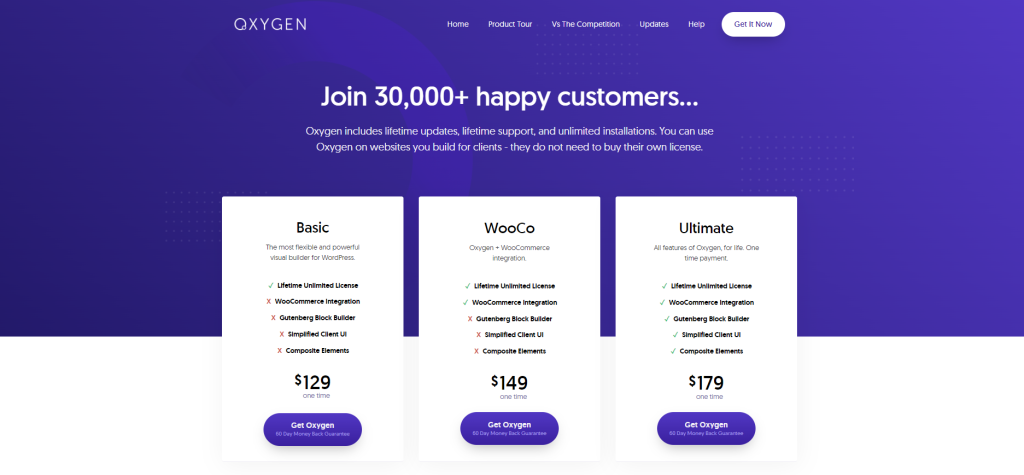
Sadly, Oxygen Builder doesn’t offer a free version but a 7-day trial if you want to get to know how it works.
This page builder plugin comes with one-time purchase plans and unlimited support, update, and licenses.
Starting at $129/one-time for unlimited websites, $149/one-time for additional WooCommerce integrations, and $179/one-time for additional block builder, simple UI, and composite elements.
Compared to Elementor Pro, Oxygen Builder costs less than a quarter with a 60-day money-back guarantee.
3. Speed Comparison - Who's Faster?
Now, all of us love speed, right?
Anything regarding site speed improvements is highly appreciated because it directly affects our user experience.
For site speed, it’s very common for page builders (complex systems) to produce a slower site compared to vanilla WordPress.
That also puts the industry best Elementor and popular Oxygen builder in the same spot.
But, there are a few key differences you should take note off.
Note:- For speed comparison, we picked both builders homepages, as the pages are made using their own plugins.
GTmetrix shows the winner
According to GTmetrix URL comparison test made on 24th September 2023, the page builders show marginal difference between them in terms of performance and speed.
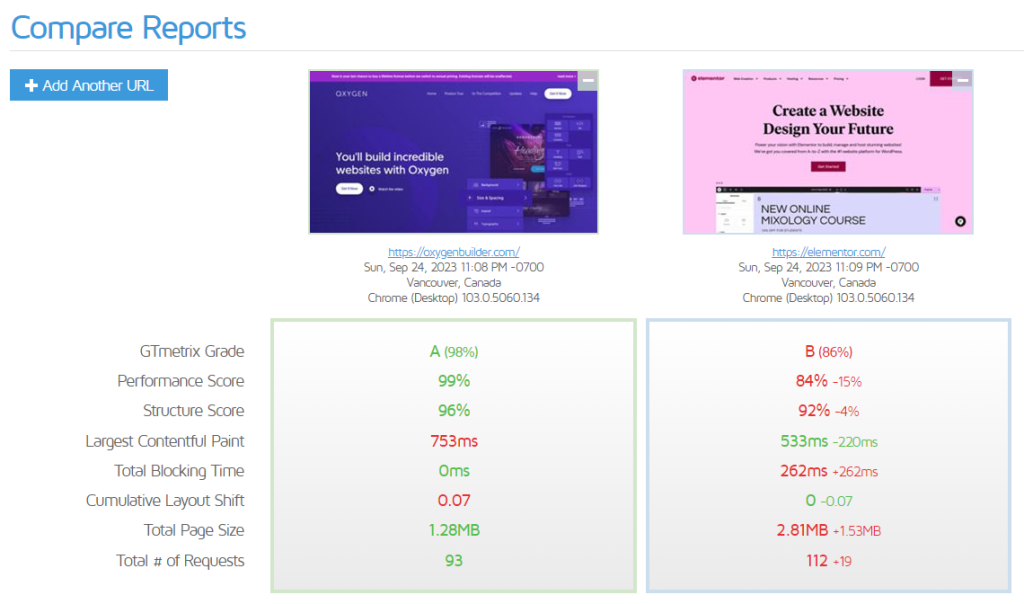
According to the result, Oxygen Builder seems to have clearly more greens than Elementor, and even stays ahead for overall performance.

But the Filmstrip speed graph shows that Oxygen falls behind there.
Note that, unlike Oxygen, Elementor landing page is filled with animations, media photos, video, and lots of fonts.
So, it might appear a bit slower due to that.
Pingdom says they are same
We could not put the thumb on the point, so we tried to see from Pingdom as well.
And…
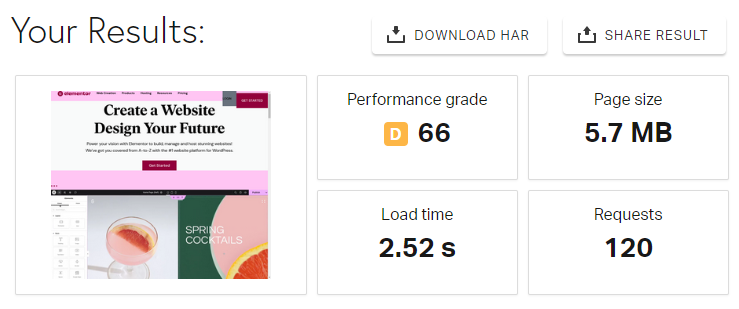
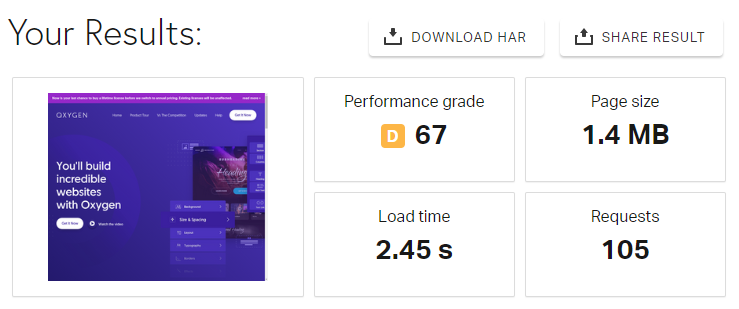
The loading time and performance score has a little difference between the two page builders.
Surprisingly, Elementor has more page size and requests, still holds the same ground as Oxygen Builder.
So, it means that the performance difference leans on the favor of Elementor here.
4. Oxygen vs Elementor - Pros and Cons
While we admit both plugins have plenty of features to offer us, there are certain pros and cons you should be aware of before purchasing.
3a. Elementor Pro - Pros & Cons
Pros
- Customize and disable the theme system at will
- Third-party theme elements are editable in the theme builder
- Simple & clean UI
- The free version has all it takes to develop unlimited websites
- 100+ Web kits
- 90+ widget modules
- 300+ ready-templates
- Custom breakpoints with CSS
- Unlimited third-party plugin integration
Cons
- Less layout automation makes the site development a bit slower for the columns and global styling
- There is no one-time purchase option available
- No lifetime deals
- Only 2 default breakpoints
- Not backed by Gutenberg
3b. Oxygen Builder - Pros & Cons
Pros
- More dynamic layout selection
- Site grid-enabled
- Class style customization saves a lot of time
- CSS transforms
- Unlimited colors for gradient
- 5 default breakpoints
- More flexbox controls
- Gutenberg block support
- More draggable elements (padding, margin, etc.)
- Advanced site design toolsets offer more freedom of customization
- Lifetime deal with a one-time purchase
Cons
- Complex UI
- A minimal number of template kits
- Less number of modules
- We need to purchase essential modules separately
- Not many third-party integrations
Elementor vs Oxygen Builder - make your choice
By reading this article, you gained the perfect idea about both page builder plugins’ features, advantages, and disadvantages.
If we talk about the scope, Oxygen Builder is clearly more powerful than Elementor in terms of flexibility and specs. But, you have to be an expert to draw out its full potential.
Compared to that, anybody can master Elementor page builder within a short amount of time. This is a great counter too.
Now, it’s up to you which one you will use to build your websites.
Let us know down in the comments.
Feel free to watch Elementor vs Oxygen Builder comparison videos from famous Tech-YouTubers
FAQs
No, it’s still going on. Due to the editor menu complexity, many beginners abandoned Oxygen Builder for a certain time and this lead into an uncertainty in the community, that the builder has shut down.
Elementor website builder plugin starts at $59/year for 1 website. [there is no lifetime deal]
Yes, for some cases. According to us and a number of others, found out that pages created with Oxygen builder is a bit faster than Elementor for the most common metrics.
Yet, the difference varies and sometimes, both builders show same page speed scores.
One popular blog by WP-Rcket has a detailed analysis answer to this question.




2 thoughts on “Elementor VS Oxygen Builder: An honest comparison review”
Alejandra
Interesting comparison. Elementor still beats the rest and it is difficult to beat it. There are also a lot of other plugins that complement elementor making it easy to design your website further to exactly your needs. For me Elementor has been and is still my go to Page builder when I design a website.
Mike
I tried Oxygen Builder in its early days and found it cumbersome, but I stuck with learning how it works, and now I’m really glad I did. For anything that uses WooCommerce and needs bespoke product pages etc, I will generally stick with Elementor, but for everything else I use oxygen, if only for the much faster page load speeds.